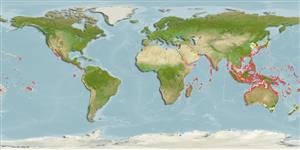Common names from other countries
Classification / Names / Names
Namen | Synonyme | Catalog of Fishes (gen., sp.) | ITIS | CoL | WoRMS
Environment: milieu / climate zone / depth range / distribution range
Ökologie
Riff-verbunden; tiefenbereich 6 - 30 m (Ref. 83472). Tropical
Indo-Pacific.
Length at first maturity / Size / Gewicht / Alter
Maturity: Lm ? range ? - ? cm
Body is almost transparent, with small brown or purple spots present at the posterior carapace and sometimes the abdomen. Body has a distinct V-shaped white and yellow patch on the third abdominal tergum. Legs and tail are white, with blue or purple near the joints and tips. Rostrum is usually arched and toothed.
In shallow waters, to depths reaching 30 meters. Mainly associated with sea anemones, but also observed on hard corals and jellyfish (Ref. 125532).
Life cycle and mating behavior
Geschlechtsreife | Fortpflanzung | Ablaichen | Eier | Fecundity | Larven
Members of the order Decapoda are mostly gonochoric. Mating behavior: Precopulatory courtship ritual is common (through olfactory and tactile cues); usually indirect sperm transfer.
Li, X. and J.Y. Liu. 2004. (Ref. 81533)
IUCN Rote Liste Status (Ref. 130435)
CITES Status (Ref. 108899)
Not Evaluated
Not Evaluated
Nutzung durch Menschen
| FishSource |
Tools
Mehr Information
Alter/GrößeWachstumLänge-GewichtLänge-LängeMorphologieLarvenDichte
Internet Quellen
Estimates based on models
Preferred temperature
(Ref.
115969): 21.4 - 29.2, mean 28.3 (based on 3670 cells).
